HIV 2 Report: Understanding HIV, its impact and preventative measures
VerifiedAdded on 2021/04/24
|8
|2173
|44
Report
AI Summary
This report provides a comprehensive overview of HIV, starting with an introduction to the virus and its impact on the human body. It details the life cycle of HIV, the mechanism of infection, and the ways in which it compromises the immune system by attacking CD4 T cells. The report further explores the psychological impacts of HIV, particularly for pregnant women, as well as preventative measures such as condom use, lubricants, Pre-Exposure Prophylaxis (PrEP), and Post-Exposure Prophylaxis (PEP). It emphasizes the importance of early detection, treatment, and the need for counseling and support for individuals living with HIV. The report also touches on the legal aspects of HIV and the importance of reporting one's health status to sexual partners to minimize the risk of transmission and promote public health. Finally, it highlights the importance of medication in managing the infection and improving the quality of life for those infected. The report concludes with a list of references used in the compilation of the report.

HIV 1
HIV
by Student’s Name
Code + Course Name
Professor’s Name
University Name
City, State
Date
HIV
by Student’s Name
Code + Course Name
Professor’s Name
University Name
City, State
Date
Paraphrase This Document
Need a fresh take? Get an instant paraphrase of this document with our AI Paraphraser
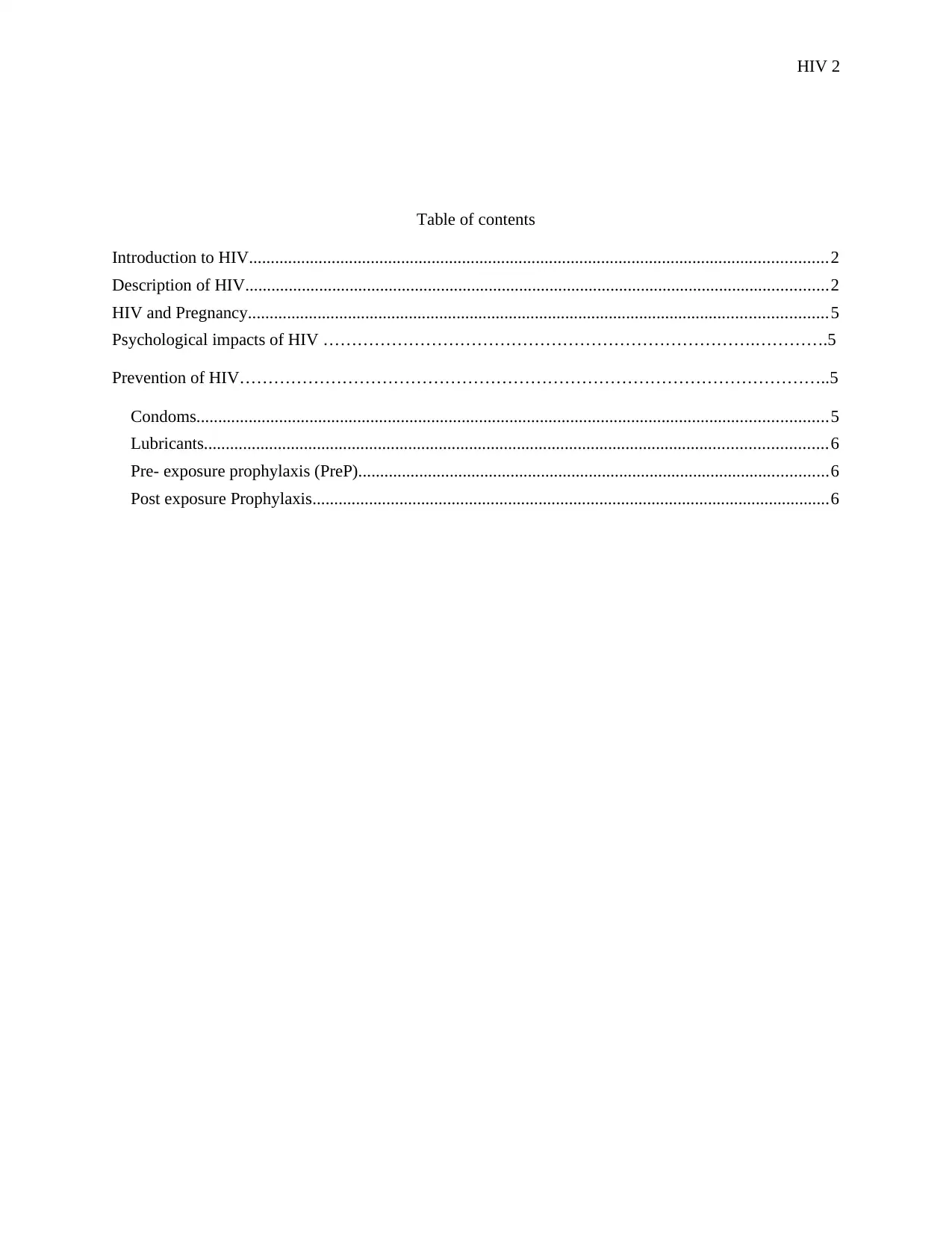
HIV 2
Table of contents
Introduction to HIV.....................................................................................................................................2
Description of HIV......................................................................................................................................2
HIV and Pregnancy.....................................................................................................................................5
Psychological impacts of HIV ………………………………………………………………….………….5
Prevention of HIV…………………………………………………………………………………………..5
Condoms.................................................................................................................................................5
Lubricants...............................................................................................................................................6
Pre- exposure prophylaxis (PreP)............................................................................................................6
Post exposure Prophylaxis.......................................................................................................................6
Table of contents
Introduction to HIV.....................................................................................................................................2
Description of HIV......................................................................................................................................2
HIV and Pregnancy.....................................................................................................................................5
Psychological impacts of HIV ………………………………………………………………….………….5
Prevention of HIV…………………………………………………………………………………………..5
Condoms.................................................................................................................................................5
Lubricants...............................................................................................................................................6
Pre- exposure prophylaxis (PreP)............................................................................................................6
Post exposure Prophylaxis.......................................................................................................................6
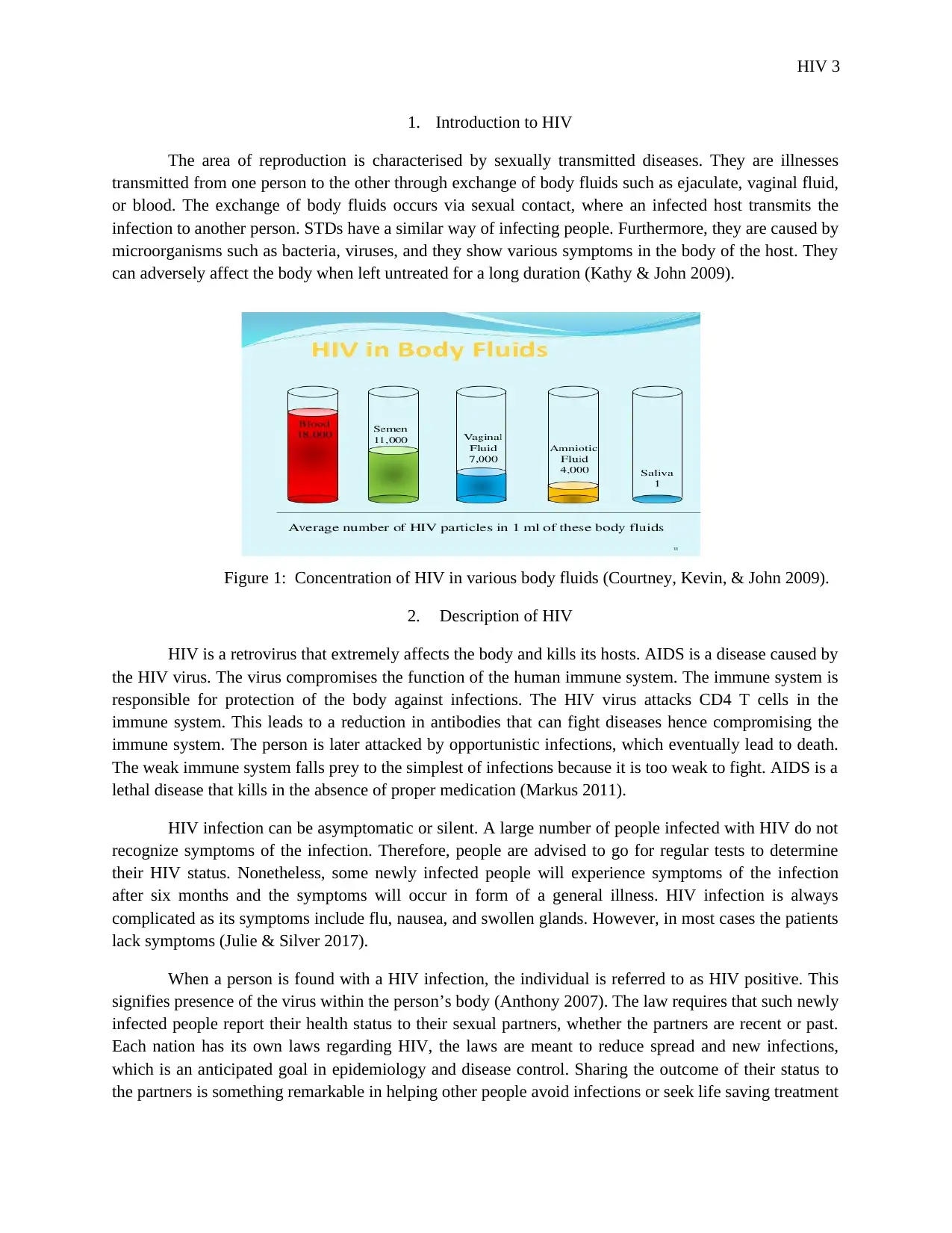
HIV 3
1. Introduction to HIV
The area of reproduction is characterised by sexually transmitted diseases. They are illnesses
transmitted from one person to the other through exchange of body fluids such as ejaculate, vaginal fluid,
or blood. The exchange of body fluids occurs via sexual contact, where an infected host transmits the
infection to another person. STDs have a similar way of infecting people. Furthermore, they are caused by
microorganisms such as bacteria, viruses, and they show various symptoms in the body of the host. They
can adversely affect the body when left untreated for a long duration (Kathy & John 2009).
Figure 1: Concentration of HIV in various body fluids (Courtney, Kevin, & John 2009).
2. Description of HIV
HIV is a retrovirus that extremely affects the body and kills its hosts. AIDS is a disease caused by
the HIV virus. The virus compromises the function of the human immune system. The immune system is
responsible for protection of the body against infections. The HIV virus attacks CD4 T cells in the
immune system. This leads to a reduction in antibodies that can fight diseases hence compromising the
immune system. The person is later attacked by opportunistic infections, which eventually lead to death.
The weak immune system falls prey to the simplest of infections because it is too weak to fight. AIDS is a
lethal disease that kills in the absence of proper medication (Markus 2011).
HIV infection can be asymptomatic or silent. A large number of people infected with HIV do not
recognize symptoms of the infection. Therefore, people are advised to go for regular tests to determine
their HIV status. Nonetheless, some newly infected people will experience symptoms of the infection
after six months and the symptoms will occur in form of a general illness. HIV infection is always
complicated as its symptoms include flu, nausea, and swollen glands. However, in most cases the patients
lack symptoms (Julie & Silver 2017).
When a person is found with a HIV infection, the individual is referred to as HIV positive. This
signifies presence of the virus within the person’s body (Anthony 2007). The law requires that such newly
infected people report their health status to their sexual partners, whether the partners are recent or past.
Each nation has its own laws regarding HIV, the laws are meant to reduce spread and new infections,
which is an anticipated goal in epidemiology and disease control. Sharing the outcome of their status to
the partners is something remarkable in helping other people avoid infections or seek life saving treatment
1. Introduction to HIV
The area of reproduction is characterised by sexually transmitted diseases. They are illnesses
transmitted from one person to the other through exchange of body fluids such as ejaculate, vaginal fluid,
or blood. The exchange of body fluids occurs via sexual contact, where an infected host transmits the
infection to another person. STDs have a similar way of infecting people. Furthermore, they are caused by
microorganisms such as bacteria, viruses, and they show various symptoms in the body of the host. They
can adversely affect the body when left untreated for a long duration (Kathy & John 2009).
Figure 1: Concentration of HIV in various body fluids (Courtney, Kevin, & John 2009).
2. Description of HIV
HIV is a retrovirus that extremely affects the body and kills its hosts. AIDS is a disease caused by
the HIV virus. The virus compromises the function of the human immune system. The immune system is
responsible for protection of the body against infections. The HIV virus attacks CD4 T cells in the
immune system. This leads to a reduction in antibodies that can fight diseases hence compromising the
immune system. The person is later attacked by opportunistic infections, which eventually lead to death.
The weak immune system falls prey to the simplest of infections because it is too weak to fight. AIDS is a
lethal disease that kills in the absence of proper medication (Markus 2011).
HIV infection can be asymptomatic or silent. A large number of people infected with HIV do not
recognize symptoms of the infection. Therefore, people are advised to go for regular tests to determine
their HIV status. Nonetheless, some newly infected people will experience symptoms of the infection
after six months and the symptoms will occur in form of a general illness. HIV infection is always
complicated as its symptoms include flu, nausea, and swollen glands. However, in most cases the patients
lack symptoms (Julie & Silver 2017).
When a person is found with a HIV infection, the individual is referred to as HIV positive. This
signifies presence of the virus within the person’s body (Anthony 2007). The law requires that such newly
infected people report their health status to their sexual partners, whether the partners are recent or past.
Each nation has its own laws regarding HIV, the laws are meant to reduce spread and new infections,
which is an anticipated goal in epidemiology and disease control. Sharing the outcome of their status to
the partners is something remarkable in helping other people avoid infections or seek life saving treatment
⊘ This is a preview!⊘
Do you want full access?
Subscribe today to unlock all pages.

Trusted by 1+ million students worldwide
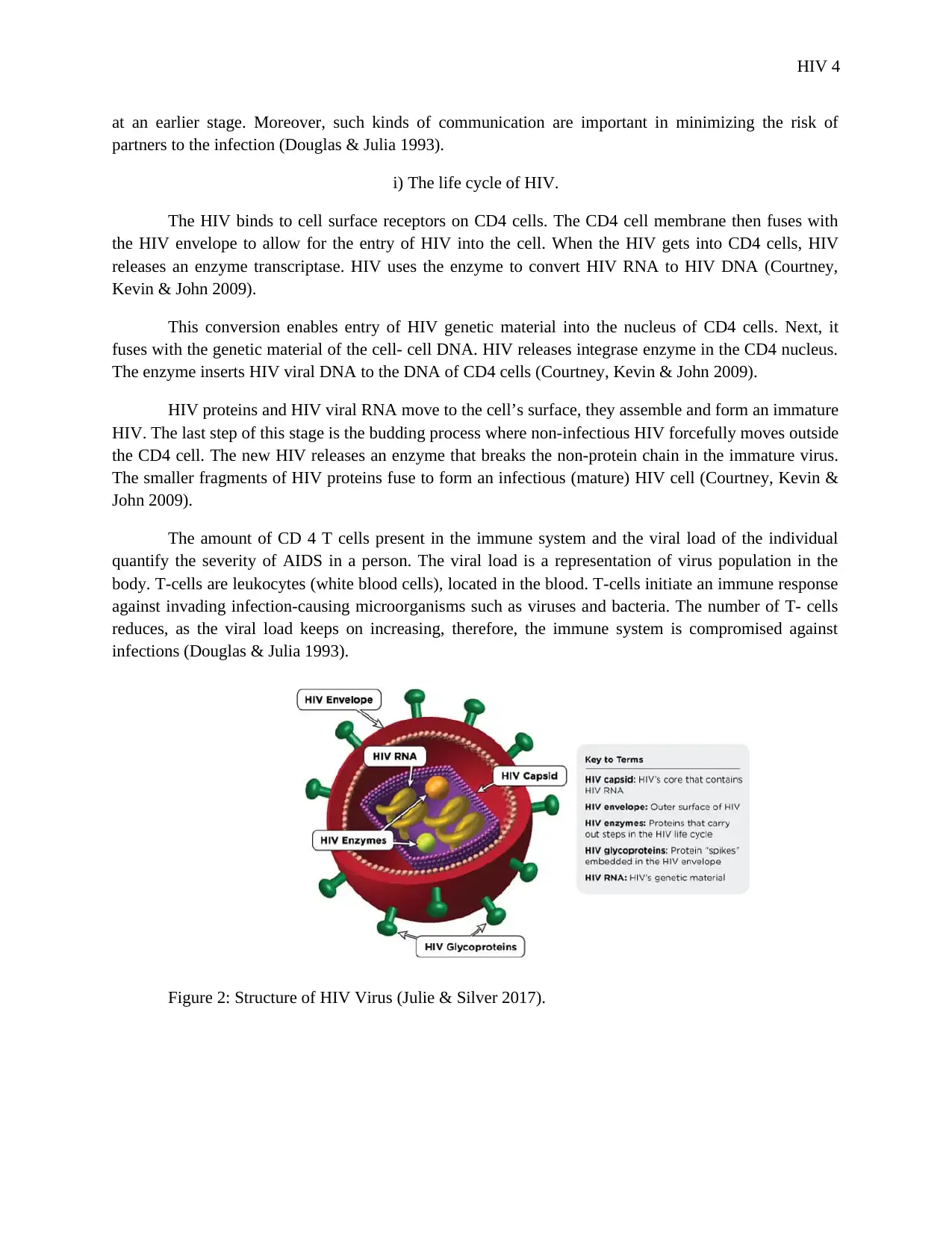
HIV 4
at an earlier stage. Moreover, such kinds of communication are important in minimizing the risk of
partners to the infection (Douglas & Julia 1993).
i) The life cycle of HIV.
The HIV binds to cell surface receptors on CD4 cells. The CD4 cell membrane then fuses with
the HIV envelope to allow for the entry of HIV into the cell. When the HIV gets into CD4 cells, HIV
releases an enzyme transcriptase. HIV uses the enzyme to convert HIV RNA to HIV DNA (Courtney,
Kevin & John 2009).
This conversion enables entry of HIV genetic material into the nucleus of CD4 cells. Next, it
fuses with the genetic material of the cell- cell DNA. HIV releases integrase enzyme in the CD4 nucleus.
The enzyme inserts HIV viral DNA to the DNA of CD4 cells (Courtney, Kevin & John 2009).
HIV proteins and HIV viral RNA move to the cell’s surface, they assemble and form an immature
HIV. The last step of this stage is the budding process where non-infectious HIV forcefully moves outside
the CD4 cell. The new HIV releases an enzyme that breaks the non-protein chain in the immature virus.
The smaller fragments of HIV proteins fuse to form an infectious (mature) HIV cell (Courtney, Kevin &
John 2009).
The amount of CD 4 T cells present in the immune system and the viral load of the individual
quantify the severity of AIDS in a person. The viral load is a representation of virus population in the
body. T-cells are leukocytes (white blood cells), located in the blood. T-cells initiate an immune response
against invading infection-causing microorganisms such as viruses and bacteria. The number of T- cells
reduces, as the viral load keeps on increasing, therefore, the immune system is compromised against
infections (Douglas & Julia 1993).
Figure 2: Structure of HIV Virus (Julie & Silver 2017).
at an earlier stage. Moreover, such kinds of communication are important in minimizing the risk of
partners to the infection (Douglas & Julia 1993).
i) The life cycle of HIV.
The HIV binds to cell surface receptors on CD4 cells. The CD4 cell membrane then fuses with
the HIV envelope to allow for the entry of HIV into the cell. When the HIV gets into CD4 cells, HIV
releases an enzyme transcriptase. HIV uses the enzyme to convert HIV RNA to HIV DNA (Courtney,
Kevin & John 2009).
This conversion enables entry of HIV genetic material into the nucleus of CD4 cells. Next, it
fuses with the genetic material of the cell- cell DNA. HIV releases integrase enzyme in the CD4 nucleus.
The enzyme inserts HIV viral DNA to the DNA of CD4 cells (Courtney, Kevin & John 2009).
HIV proteins and HIV viral RNA move to the cell’s surface, they assemble and form an immature
HIV. The last step of this stage is the budding process where non-infectious HIV forcefully moves outside
the CD4 cell. The new HIV releases an enzyme that breaks the non-protein chain in the immature virus.
The smaller fragments of HIV proteins fuse to form an infectious (mature) HIV cell (Courtney, Kevin &
John 2009).
The amount of CD 4 T cells present in the immune system and the viral load of the individual
quantify the severity of AIDS in a person. The viral load is a representation of virus population in the
body. T-cells are leukocytes (white blood cells), located in the blood. T-cells initiate an immune response
against invading infection-causing microorganisms such as viruses and bacteria. The number of T- cells
reduces, as the viral load keeps on increasing, therefore, the immune system is compromised against
infections (Douglas & Julia 1993).
Figure 2: Structure of HIV Virus (Julie & Silver 2017).
Paraphrase This Document
Need a fresh take? Get an instant paraphrase of this document with our AI Paraphraser
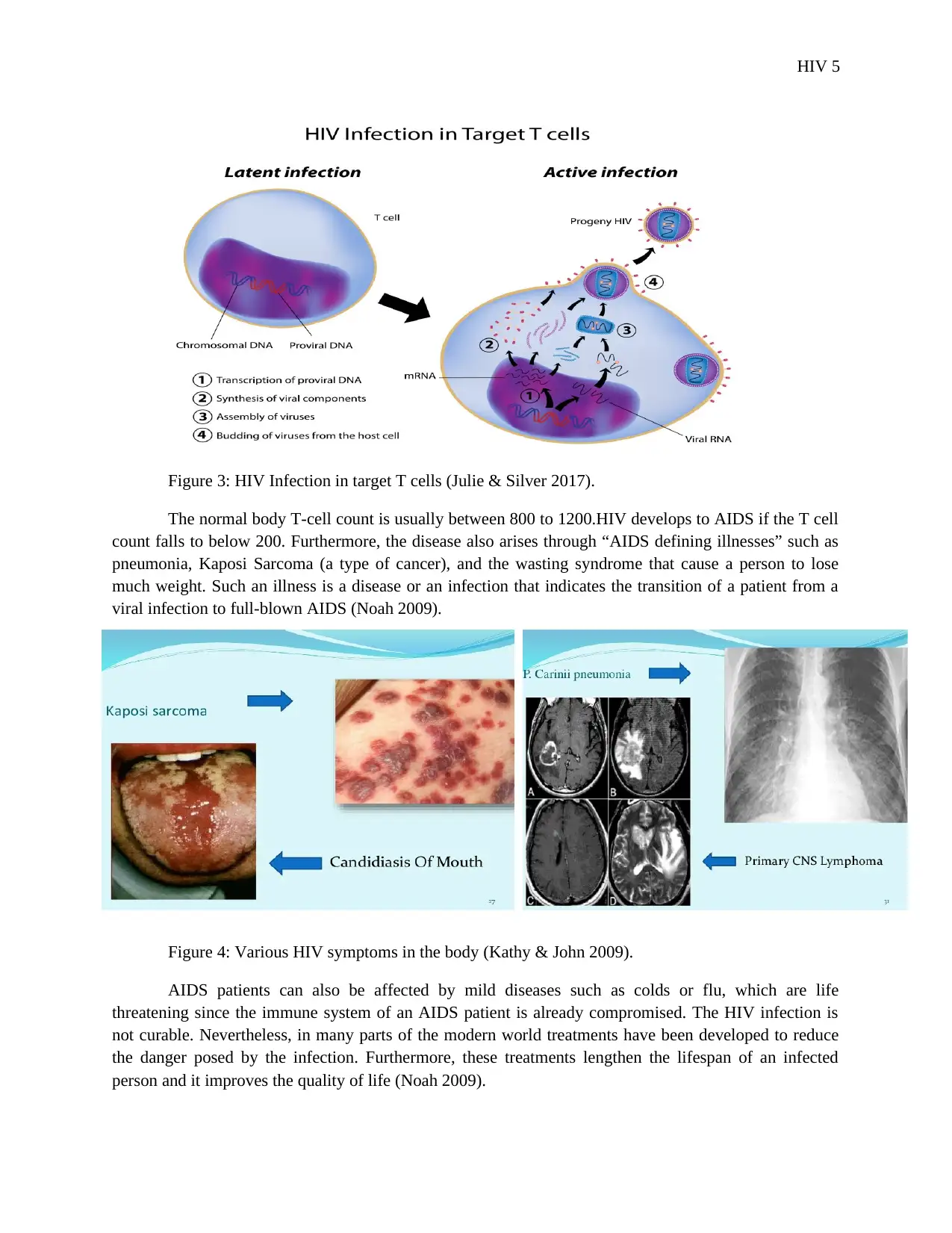
HIV 5
Figure 3: HIV Infection in target T cells (Julie & Silver 2017).
The normal body T-cell count is usually between 800 to 1200.HIV develops to AIDS if the T cell
count falls to below 200. Furthermore, the disease also arises through “AIDS defining illnesses” such as
pneumonia, Kaposi Sarcoma (a type of cancer), and the wasting syndrome that cause a person to lose
much weight. Such an illness is a disease or an infection that indicates the transition of a patient from a
viral infection to full-blown AIDS (Noah 2009).
Figure 4: Various HIV symptoms in the body (Kathy & John 2009).
AIDS patients can also be affected by mild diseases such as colds or flu, which are life
threatening since the immune system of an AIDS patient is already compromised. The HIV infection is
not curable. Nevertheless, in many parts of the modern world treatments have been developed to reduce
the danger posed by the infection. Furthermore, these treatments lengthen the lifespan of an infected
person and it improves the quality of life (Noah 2009).
Figure 3: HIV Infection in target T cells (Julie & Silver 2017).
The normal body T-cell count is usually between 800 to 1200.HIV develops to AIDS if the T cell
count falls to below 200. Furthermore, the disease also arises through “AIDS defining illnesses” such as
pneumonia, Kaposi Sarcoma (a type of cancer), and the wasting syndrome that cause a person to lose
much weight. Such an illness is a disease or an infection that indicates the transition of a patient from a
viral infection to full-blown AIDS (Noah 2009).
Figure 4: Various HIV symptoms in the body (Kathy & John 2009).
AIDS patients can also be affected by mild diseases such as colds or flu, which are life
threatening since the immune system of an AIDS patient is already compromised. The HIV infection is
not curable. Nevertheless, in many parts of the modern world treatments have been developed to reduce
the danger posed by the infection. Furthermore, these treatments lengthen the lifespan of an infected
person and it improves the quality of life (Noah 2009).
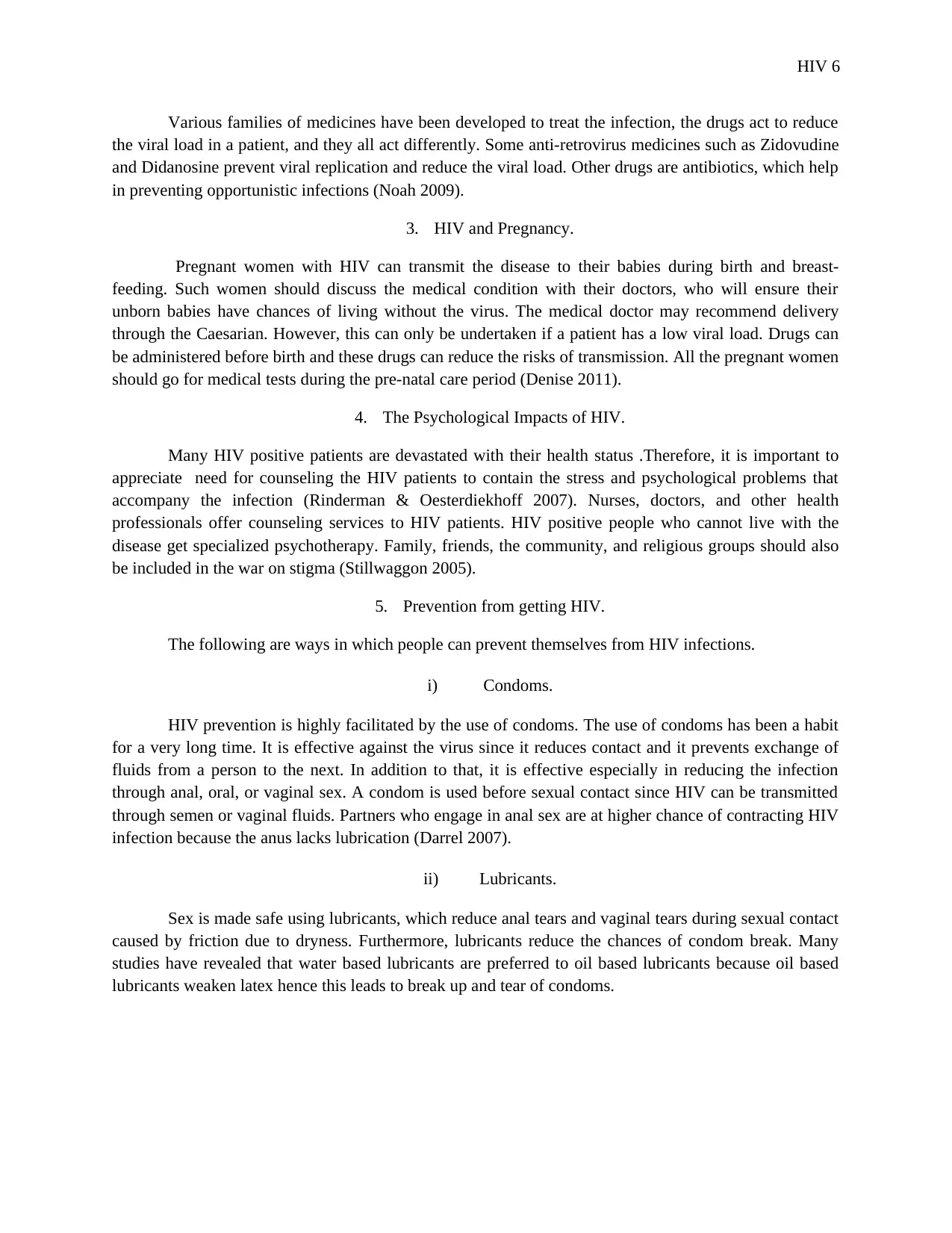
HIV 6
Various families of medicines have been developed to treat the infection, the drugs act to reduce
the viral load in a patient, and they all act differently. Some anti-retrovirus medicines such as Zidovudine
and Didanosine prevent viral replication and reduce the viral load. Other drugs are antibiotics, which help
in preventing opportunistic infections (Noah 2009).
3. HIV and Pregnancy.
Pregnant women with HIV can transmit the disease to their babies during birth and breast-
feeding. Such women should discuss the medical condition with their doctors, who will ensure their
unborn babies have chances of living without the virus. The medical doctor may recommend delivery
through the Caesarian. However, this can only be undertaken if a patient has a low viral load. Drugs can
be administered before birth and these drugs can reduce the risks of transmission. All the pregnant women
should go for medical tests during the pre-natal care period (Denise 2011).
4. The Psychological Impacts of HIV.
Many HIV positive patients are devastated with their health status .Therefore, it is important to
appreciate need for counseling the HIV patients to contain the stress and psychological problems that
accompany the infection (Rinderman & Oesterdiekhoff 2007). Nurses, doctors, and other health
professionals offer counseling services to HIV patients. HIV positive people who cannot live with the
disease get specialized psychotherapy. Family, friends, the community, and religious groups should also
be included in the war on stigma (Stillwaggon 2005).
5. Prevention from getting HIV.
The following are ways in which people can prevent themselves from HIV infections.
i) Condoms.
HIV prevention is highly facilitated by the use of condoms. The use of condoms has been a habit
for a very long time. It is effective against the virus since it reduces contact and it prevents exchange of
fluids from a person to the next. In addition to that, it is effective especially in reducing the infection
through anal, oral, or vaginal sex. A condom is used before sexual contact since HIV can be transmitted
through semen or vaginal fluids. Partners who engage in anal sex are at higher chance of contracting HIV
infection because the anus lacks lubrication (Darrel 2007).
ii) Lubricants.
Sex is made safe using lubricants, which reduce anal tears and vaginal tears during sexual contact
caused by friction due to dryness. Furthermore, lubricants reduce the chances of condom break. Many
studies have revealed that water based lubricants are preferred to oil based lubricants because oil based
lubricants weaken latex hence this leads to break up and tear of condoms.
Various families of medicines have been developed to treat the infection, the drugs act to reduce
the viral load in a patient, and they all act differently. Some anti-retrovirus medicines such as Zidovudine
and Didanosine prevent viral replication and reduce the viral load. Other drugs are antibiotics, which help
in preventing opportunistic infections (Noah 2009).
3. HIV and Pregnancy.
Pregnant women with HIV can transmit the disease to their babies during birth and breast-
feeding. Such women should discuss the medical condition with their doctors, who will ensure their
unborn babies have chances of living without the virus. The medical doctor may recommend delivery
through the Caesarian. However, this can only be undertaken if a patient has a low viral load. Drugs can
be administered before birth and these drugs can reduce the risks of transmission. All the pregnant women
should go for medical tests during the pre-natal care period (Denise 2011).
4. The Psychological Impacts of HIV.
Many HIV positive patients are devastated with their health status .Therefore, it is important to
appreciate need for counseling the HIV patients to contain the stress and psychological problems that
accompany the infection (Rinderman & Oesterdiekhoff 2007). Nurses, doctors, and other health
professionals offer counseling services to HIV patients. HIV positive people who cannot live with the
disease get specialized psychotherapy. Family, friends, the community, and religious groups should also
be included in the war on stigma (Stillwaggon 2005).
5. Prevention from getting HIV.
The following are ways in which people can prevent themselves from HIV infections.
i) Condoms.
HIV prevention is highly facilitated by the use of condoms. The use of condoms has been a habit
for a very long time. It is effective against the virus since it reduces contact and it prevents exchange of
fluids from a person to the next. In addition to that, it is effective especially in reducing the infection
through anal, oral, or vaginal sex. A condom is used before sexual contact since HIV can be transmitted
through semen or vaginal fluids. Partners who engage in anal sex are at higher chance of contracting HIV
infection because the anus lacks lubrication (Darrel 2007).
ii) Lubricants.
Sex is made safe using lubricants, which reduce anal tears and vaginal tears during sexual contact
caused by friction due to dryness. Furthermore, lubricants reduce the chances of condom break. Many
studies have revealed that water based lubricants are preferred to oil based lubricants because oil based
lubricants weaken latex hence this leads to break up and tear of condoms.
⊘ This is a preview!⊘
Do you want full access?
Subscribe today to unlock all pages.

Trusted by 1+ million students worldwide
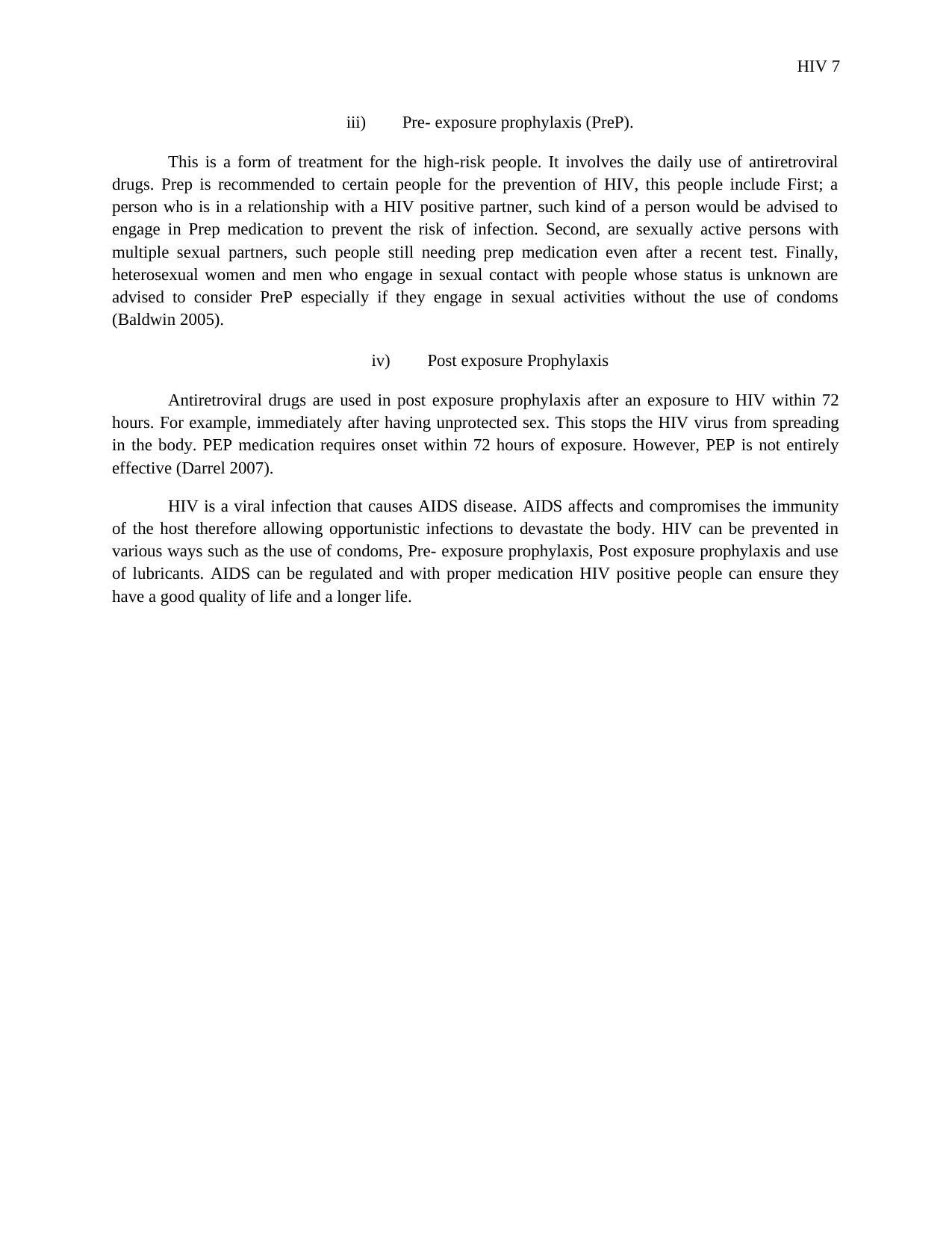
HIV 7
iii) Pre- exposure prophylaxis (PreP).
This is a form of treatment for the high-risk people. It involves the daily use of antiretroviral
drugs. Prep is recommended to certain people for the prevention of HIV, this people include First; a
person who is in a relationship with a HIV positive partner, such kind of a person would be advised to
engage in Prep medication to prevent the risk of infection. Second, are sexually active persons with
multiple sexual partners, such people still needing prep medication even after a recent test. Finally,
heterosexual women and men who engage in sexual contact with people whose status is unknown are
advised to consider PreP especially if they engage in sexual activities without the use of condoms
(Baldwin 2005).
iv) Post exposure Prophylaxis
Antiretroviral drugs are used in post exposure prophylaxis after an exposure to HIV within 72
hours. For example, immediately after having unprotected sex. This stops the HIV virus from spreading
in the body. PEP medication requires onset within 72 hours of exposure. However, PEP is not entirely
effective (Darrel 2007).
HIV is a viral infection that causes AIDS disease. AIDS affects and compromises the immunity
of the host therefore allowing opportunistic infections to devastate the body. HIV can be prevented in
various ways such as the use of condoms, Pre- exposure prophylaxis, Post exposure prophylaxis and use
of lubricants. AIDS can be regulated and with proper medication HIV positive people can ensure they
have a good quality of life and a longer life.
iii) Pre- exposure prophylaxis (PreP).
This is a form of treatment for the high-risk people. It involves the daily use of antiretroviral
drugs. Prep is recommended to certain people for the prevention of HIV, this people include First; a
person who is in a relationship with a HIV positive partner, such kind of a person would be advised to
engage in Prep medication to prevent the risk of infection. Second, are sexually active persons with
multiple sexual partners, such people still needing prep medication even after a recent test. Finally,
heterosexual women and men who engage in sexual contact with people whose status is unknown are
advised to consider PreP especially if they engage in sexual activities without the use of condoms
(Baldwin 2005).
iv) Post exposure Prophylaxis
Antiretroviral drugs are used in post exposure prophylaxis after an exposure to HIV within 72
hours. For example, immediately after having unprotected sex. This stops the HIV virus from spreading
in the body. PEP medication requires onset within 72 hours of exposure. However, PEP is not entirely
effective (Darrel 2007).
HIV is a viral infection that causes AIDS disease. AIDS affects and compromises the immunity
of the host therefore allowing opportunistic infections to devastate the body. HIV can be prevented in
various ways such as the use of condoms, Pre- exposure prophylaxis, Post exposure prophylaxis and use
of lubricants. AIDS can be regulated and with proper medication HIV positive people can ensure they
have a good quality of life and a longer life.
Paraphrase This Document
Need a fresh take? Get an instant paraphrase of this document with our AI Paraphraser
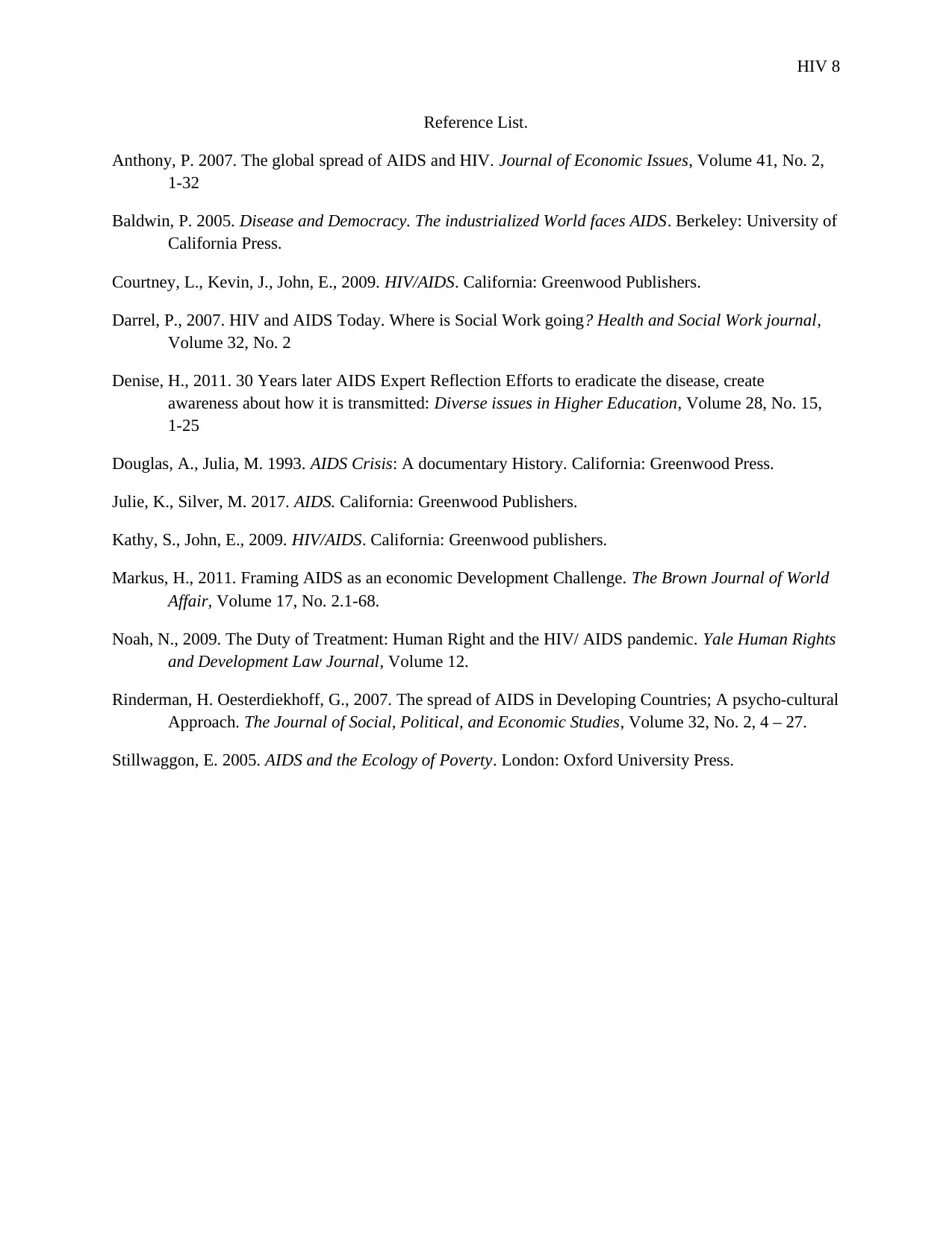
HIV 8
Reference List.
Anthony, P. 2007. The global spread of AIDS and HIV. Journal of Economic Issues, Volume 41, No. 2,
1-32
Baldwin, P. 2005. Disease and Democracy. The industrialized World faces AIDS. Berkeley: University of
California Press.
Courtney, L., Kevin, J., John, E., 2009. HIV/AIDS. California: Greenwood Publishers.
Darrel, P., 2007. HIV and AIDS Today. Where is Social Work going? Health and Social Work journal,
Volume 32, No. 2
Denise, H., 2011. 30 Years later AIDS Expert Reflection Efforts to eradicate the disease, create
awareness about how it is transmitted: Diverse issues in Higher Education, Volume 28, No. 15,
1-25
Douglas, A., Julia, M. 1993. AIDS Crisis: A documentary History. California: Greenwood Press.
Julie, K., Silver, M. 2017. AIDS. California: Greenwood Publishers.
Kathy, S., John, E., 2009. HIV/AIDS. California: Greenwood publishers.
Markus, H., 2011. Framing AIDS as an economic Development Challenge. The Brown Journal of World
Affair, Volume 17, No. 2.1-68.
Noah, N., 2009. The Duty of Treatment: Human Right and the HIV/ AIDS pandemic. Yale Human Rights
and Development Law Journal, Volume 12.
Rinderman, H. Oesterdiekhoff, G., 2007. The spread of AIDS in Developing Countries; A psycho-cultural
Approach. The Journal of Social, Political, and Economic Studies, Volume 32, No. 2, 4 – 27.
Stillwaggon, E. 2005. AIDS and the Ecology of Poverty. London: Oxford University Press.
Reference List.
Anthony, P. 2007. The global spread of AIDS and HIV. Journal of Economic Issues, Volume 41, No. 2,
1-32
Baldwin, P. 2005. Disease and Democracy. The industrialized World faces AIDS. Berkeley: University of
California Press.
Courtney, L., Kevin, J., John, E., 2009. HIV/AIDS. California: Greenwood Publishers.
Darrel, P., 2007. HIV and AIDS Today. Where is Social Work going? Health and Social Work journal,
Volume 32, No. 2
Denise, H., 2011. 30 Years later AIDS Expert Reflection Efforts to eradicate the disease, create
awareness about how it is transmitted: Diverse issues in Higher Education, Volume 28, No. 15,
1-25
Douglas, A., Julia, M. 1993. AIDS Crisis: A documentary History. California: Greenwood Press.
Julie, K., Silver, M. 2017. AIDS. California: Greenwood Publishers.
Kathy, S., John, E., 2009. HIV/AIDS. California: Greenwood publishers.
Markus, H., 2011. Framing AIDS as an economic Development Challenge. The Brown Journal of World
Affair, Volume 17, No. 2.1-68.
Noah, N., 2009. The Duty of Treatment: Human Right and the HIV/ AIDS pandemic. Yale Human Rights
and Development Law Journal, Volume 12.
Rinderman, H. Oesterdiekhoff, G., 2007. The spread of AIDS in Developing Countries; A psycho-cultural
Approach. The Journal of Social, Political, and Economic Studies, Volume 32, No. 2, 4 – 27.
Stillwaggon, E. 2005. AIDS and the Ecology of Poverty. London: Oxford University Press.
1 out of 8
Related Documents
Your All-in-One AI-Powered Toolkit for Academic Success.
+13062052269
info@desklib.com
Available 24*7 on WhatsApp / Email
![[object Object]](/_next/static/media/star-bottom.7253800d.svg)
Unlock your academic potential
Copyright © 2020–2025 A2Z Services. All Rights Reserved. Developed and managed by ZUCOL.





